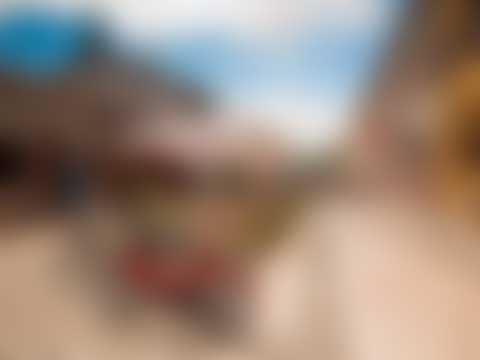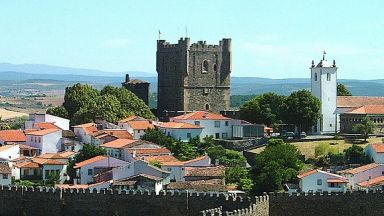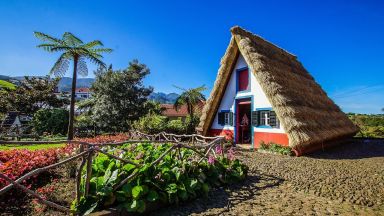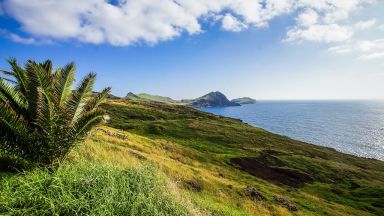Free Walking Tour of Bragança (with Maps!)
This website uses affiliate links which earn a small commission at no additional cost to you.
Located in Trás-os-Montes, just below the Montesinho Natural Park, is Bragança – a historic city with a dual personality. At one end lies the old town centre, protected by medieval battlements and crowned by a castle atop a hill; at the other end is the new town, featuring whitewashed urban houses and the tranquil Fervença river flowing at its feet.
While most of Bragança’s main attractions are situated within the citadel, venturing beyond the walls presents an opportunity to connect with nature and unwind on the river beaches.
Explore Bragança’s Citadel

Best place to park is at the carpark by the castle, with the best approach being from the east and the A4. From the car park you have easy access to the Igreja de Santa Maria, Domus Municipalis and the city walls.
Venturing into Bragança’s citadel is like taking a step back in time to the 12th century, where crenellated walls surround the city’s old town. To access it, you’ll need to ascend towards the tower. Once inside, you’ll encounter an array of eateries, artisan shops, and numerous city landmarks, including the castle. Dating back to the 15th century, it stands out as one of Bragança’s most iconic structures.
Nowadays, it houses the Museu Militar De Bragança which has an impressive collection of weaponry, ranging from medieval to the dictatorship era. After exploring the exhibit, be sure to climb the 33-metre-high keep for breathtaking panoramic views of the city and Montesinho Natural Park. The ramparts are also remarkably well-preserved, allowing you to take a leisurely stroll around the centre from up high.
Location: Castelo de Bragança, Rua Dom João V, Bragança, Portugal | Hours: 9:00 a.m. - 12:00 a.m. | 2:00 p.m. to 5:00 p.m. Closed on Mondays and national holidays. In August it does not close during lunch time
Read more about Castelo de Bragança
See the Igreja de Santa Maria

Just a few steps away from the castle, you’ll find the Igreja de Santa Maria, one of the oldest churches in Bragança dating back to the 16th century. Over the years, it underwent various modifications, resulting in a fusion of styles ranging from Renaissance to Baroque. The front doorway is an eye-catching feature, featuring two embellished columns, but it’s worth venturing inside to witness the opulent altar and the vivid painting of the Assumption adorning the ceiling.
Location: Igreja de Santa Maria, Rua da Cidadela, Bragança, Portugal | Hours: Open every day from 9:30 am to 5:30 pm. | Website
Read more about Igreja de Santa Maria (Bragança)
Domus Municipalis

Beside the church is the Domus Municipalis, a distinctive five-sided structure that stands out as one of the rare examples of Romanesque architecture in Portugal. While its exact date of construction is a matter of debate among historians, it is believed to have been built in the 13th or 14th century. Carved medallions adorn the semicircular windows, both inside and outside the building. The terracotta roof, however, was added in the 20th century as part of a major restoration project.
Location: Domus Municipalis, Rua da Cidadela, Bragança, Portugal
Read more about Domus Municipalis (Bragança)
Igreja de São Vicente (Bragança)

From the carpark climb the city walls and walk anti clockwise around. When you reach the east gate descend the steps and walk down into the town along R. Trindade Coelho until you reach a triangular plaza. The plaza has a war memorial in the centre and the Igreja de São Vicente to your right.
Dating back to the 13th century, this temple originated as a parish church before being rebuilt in the 16th century on the orders of Bishop D. António Pinheiro, and later in the 17th century following a landslide. Although the medieval apse structure was retained, significant alterations were made in the Baroque style.
The church’s unadorned exterior is distinguished by a Mannerist-style side portal typical of convent churches. Inside, the chancel is a noteworthy feature with its polychromatic vegetal ornamentation and starry vault, while the gilded rocaille-style carvings on the triumphal arch and side altarpieces are also noteworthy.
The church is renowned for its association with the legendary tale of the secret marriage between King D. Pedro (reigned 1357-67) and court lady Inês de Castro in 1352, which was celebrated by the dean of the Sé da Guarda, D. Gil. Additionally, in 1808, General Sepúlveda famously proclaimed his opposition to the French invasion led by Junot to the people of Bragança, and this event was commemorated on a tile panel placed on the south façade in 1929.
Location: Igreja de São Vicente, Rua Combatentes da Grande Guerra, Bragança, Portugal
Read more about Igreja de São Vicente (Bragança)
Museu do Abade de Baçal

Leave the square behind the church and turn left onto R. Abílio Beça.
Located outside the citadel walls in the lower town, Bragança’s former episcopal palace now serves as a museum for the Northeast Trasmontano region. The museum’s collections include various works of art, archaeological artifacts, and coins, donated by local writers and military figures. There are also several religious treasures on display, including a wooden ark for holy anointing oils, a triptych depicting the martyrdom of St. Ignatius, and several Baroque polychrome statues.
The museum showcases the region’s history, including the standard measures for liquids and weights from the 16th-century Manueline period, highlighting Bragança’s significance during that time. Additionally, visitors can find hand-axes, arrowheads, funerary steles, coins, milestones, and ceramics from ancient times.
Location: Museu do Abade de Baçal, Rua Abílio Beça, Bragança, Portugal | Hours: 9h30 a.m. - 12:30 p.m. | 2:00 p.m. to 6:00 p.m. Closed: Mondays, 1 January, Easter Sunday, 1 May, 25 December. | Website
Read more about Museu do Abade de Baçal
Visit the Old and the New Cathedral

Leave the museum and turn right onto R. Abílio Beça and walk along until you reach Centro de Arte Contemporânea Graça Morais. Opposite the art gallery is the Praça da Sé.
Dating back to the 16th century, the Igreja de São João Baptista served as Bragança’s original cathedral. Its Renaissance-style entrance and bell tower with arched windows are prominent features against the white walls. The Baroque-style gilded altar takes center stage inside the church, and a small patio surrounded by cloisters is accessible.
In 2001, a new cathedral, the Igreja de Nossa Senhora Rainha, was erected just a few steps away from the old one. This contemporary church was designed by architect Vassalo Rosa and boasts an impressive ceramic panel behind the altar, making it worth a visit.
Location: Igreja de São João Baptista (antiga Sé de Bragança), Rua Alexandre Herculano, Bragança, Portugal
Read more about Sé Velha de Bragança
Walk behind the church to see the river. Either walk along the river back to the castle, or cross over and climb up to the Miradouro do Castelo de Bragança. If that cardio was not enough there is another viewing point further up the steps at the Miradouro do Bartholomew
This website uses affiliate links which earn a small commission at no additional cost to you.



